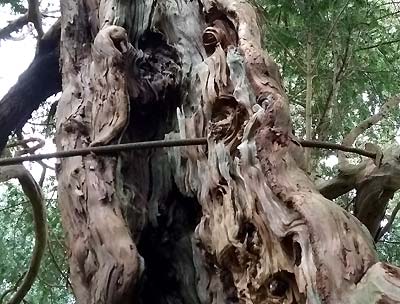Preserving Farringdon’s Ancient Yew
Worshippers and residents of Farringdon and Chawton will be very familiar with the Yew in All Saints churchyard.
 What you may not know is that the tree is classified as "Ancient Exceptional" and is listed on the Ancient Yew Tree Inventory as a “Tree of National Special Interest”.
Experts have placed it in the top 20 of the UK’s oldest churchyard yews.
What you may not know is that the tree is classified as "Ancient Exceptional" and is listed on the Ancient Yew Tree Inventory as a “Tree of National Special Interest”.
Experts have placed it in the top 20 of the UK’s oldest churchyard yews.
Sadly, our tree is now showing signs of moderate to mid-decline, with sections of the tree being quite fragile and less able to maintain their structural stability. Action now needs to be taken to ensure its survival for future generations.
Published reports state that Great Britain has the highest number of ancient yew trees on earth, with a mere 157 being older than 2000 years. Given that they are the oldest living things in Great Britain, it will come as a surprise that yew trees are unprotected, and there are no laws to stop them from being cut down or vandalised. Fortunately for us, the churchyard is within the South Downs National Park, which gives it a degree of protection.
This summer the first detailed condition and management study since 1998 was undertaken by one of the country’s leading arboriculturists, who measured and dated the tree. The results revealed a basal girth of 9.27m at its narrowest point, thereby ageing the tree at well over 2000 years and classifying it as ‘Exceptional’ and confirming its status as one of Great Britain’s most important trees. The yew tree is one of our oldest native species and was held sacred in pre-Christian times. Because of their longevity and ability to regenerate - old drooping branches can root and form new trunks - the yew tree has become a symbol of death and resurrection.
It is for these reasons that yew trees are associated with old churches and are not typically found outside churchyards. In fact, the oldest trees, such as ours, were growing well before the earliest churches were built. From a practical point of view, uses for the yew tree are rather limited. Historically its hardwood was used for furniture-making and also for medieval long bows.
The importance of the Farringdon Ancient Yew cannot be understated. For this reason The Parochial Church Council is setting out to harness the support of national organisations working in the areas of arboriculture, conservation and the environment in order to raise awareness of the plight of the tree and to raise funds to build a discrete structure to support the tree and save it for future generations.
Additional supports have recently been positioned under several boughs to protect them from adverse weather conditions over the coming winter months. If you would like to find out more about this historic yew tree, or would like to play a role in securing its future then All Saints PCC would be pleased to hear from you.
Regular updates on how our campaign progresses will be published on this web site and in the village magazine over the coming months.
Bryan Orchard, All Saints PCC

